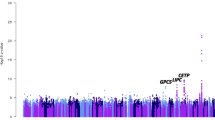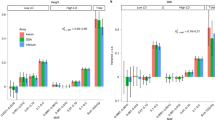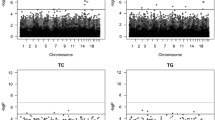Abstract
We previously identified a low-frequency (1.1 %) coding variant (G45R; rs200573126) in the adiponectin gene (ADIPOQ) which was the basis for a multipoint microsatellite linkage signal (LOD = 8.2) for plasma adiponectin levels in Hispanic families. We have empirically evaluated the ability of data from targeted common variants, exome chip genotyping, and genome-wide association study data to detect linkage and association to adiponectin protein levels at this locus. Simple two-point linkage and association analyses were performed in 88 Hispanic families (1,150 individuals) using 10,958 SNPs on chromosome 3. Approaches were compared for their ability to map the functional variant, G45R, which was strongly linked (two-point LOD = 20.98) and powerfully associated (p value = 8.1 × 10−50). Over 450 SNPs within a broad 61 Mb interval around rs200573126 showed nominal evidence of linkage (LOD > 3) but only four other SNPs in this region were associated with p values < 1.0 × 10−4. When G45R was accounted for, the maximum LOD score across the interval dropped to 4.39 and the best p value was 1.1 × 10−5. Linked and/or associated variants ranged in frequency (0.0018–0.50) and type (coding, non-coding) and had little detectable linkage disequilibrium with rs200573126 (r 2 < 0.20). In addition, the two-point linkage approach empirically outperformed multipoint microsatellite and multipoint SNP analysis. In the absence of data for rs200573126, family-based linkage analysis using a moderately dense SNP dataset, including both common and low-frequency variants, resulted in stronger evidence for an adiponectin locus than association data alone. Thus, linkage analysis can be a useful tool to facilitate identification of high-impact genetic variants.



Similar content being viewed by others
References
Alexander DH, Novembre J, Lange K (2009) Fast model-based estimation of ancestry in unrelated individuals. Genome Res 19:1655–1664. doi:10.1101/gr.094052.109
Almasy L, Blangero J (1998) Multipoint quantitative-trait linkage analysis in general pedigrees. Am J Hum Genet 62:1198–1211. doi:10.1086/301844
An SS, Hanley AJ, Ziegler JT, Brown WM, Haffner SM, Norris JM, Rotter JI, Guo X, Chen YD, Wagenknecht LE, Langefeld CD, Bowden DW, Palmer ND (2012) Association between ADIPOQ SNPs with plasma adiponectin and glucose homeostasis and adiposity phenotypes in the IRAS Family Study. Mol Genet Metab 107:721–728. doi:10.1016/j.ymgme.2012.10.003
An SS, Palmer ND, Hanley AJ, Ziegler JT, Brown WM, Haffner SM, Norris JM, Rotter JI, Guo X, Chen YD, Wagenknecht LE, Langefeld CD, Bowden DW (2013) Estimating the contributions of rare and common genetic variations and clinical measures to a model trait: adiponectin. Genet Epidemiol 37:13–24. doi:10.1002/gepi.21685
Bowden DW, An SS, Palmer ND, Brown WM, Norris JM, Haffner SM, Hawkins GA, Guo X, Rotter JI, Chen YD, Wagenknecht LE, Langefeld CD (2010) Molecular basis of a linkage peak: exome sequencing and family-based analysis identify a rare genetic variant in the ADIPOQ gene in the IRAS Family Study. Hum Mol Genet 19:4112–4120. doi:10.1093/hmg/ddq327
Goodarzi MO, Langefeld CD, Xiang AH, Chen YD, Guo X, Hanley AJ, Raffel LJ, Kandeel F, Buchanan TA, Norris JM, Fingerlin TE, Lorenzo C, Rewers MJ, Haffner SM, Bowden DW, Rich SS, Bergman RN, Rotter JI, Watanabe RM, Wagenknecht LE (2013) Insulin sensitivity and insulin clearance are heritable and have strong genetic correlation in Mexican Americans. Obesity. doi:10.1002/oby.20639
Guo X, Saad MF, Langefeld CD, Williams AH, Cui J, Taylor KD, Norris JM, Jinagouda S, Darwin CH, Mitchell BD, Bergman RN, Sutton B, Chen YD, Wagenknecht LE, Bowden DW, Rotter JI (2006) Genome-wide linkage of plasma adiponectin reveals a major locus on chromosome 3q distinct from the adiponectin structural gene: the IRAS family study. Diabetes 55:1723–1730. doi:10.2337/db05-0428
Heath SC (1997) Markov chain Monte Carlo segregation and linkage analysis for oligogenic models. Am J Hum Genet 61:748–760. doi:10.1086/515506
Heath SC, Snow GL, Thompson EA, Tseng C, Wijsman EM (1997) MCMC segregation and linkage analysis. Genet Epidemiol 14:1011–1016. doi:10.1002/(sici)1098-2272(1997)14:6<1011:aid-gepi75>3.0.co;2-l
Hellwege JN, Palmer ND, Raffield LM, Ng MC, Hawkins GA, Long J, Lorenzo C, Norris JM, Ida Chen YD, Speliotes EK, Rotter JI, Langefeld CD, Wagenknecht LE, Bowden DW (2014) Genome-wide family-based linkage analysis of exome chip variants and cardiometabolic risk. Genet Epidemiol 38:345–352. doi:10.1002/gepi.21801
Henkin L, Bergman RN, Bowden DW, Ellsworth DL, Haffner SM, Langefeld CD, Mitchell BD, Norris JM, Rewers M, Saad MF, Stamm E, Wagenknecht LE, Rich SS (2003) Genetic epidemiology of insulin resistance and visceral adiposity. The IRAS Family study design and methods. Ann Epidemiol 13:211–217
Kiezun A, Garimella K, Do R, Stitziel NO, Neale BM, McLaren PJ, Gupta N, Sklar P, Sullivan PF, Moran JL, Hultman CM, Lichtenstein P, Magnusson P, Lehner T, Shugart YY, Price AL, de Bakker PI, Purcell SM, Sunyaev SR (2012) Exome sequencing and the genetic basis of complex traits. Nat Genet 44:623–630. doi:10.1038/ng.2303
Manolio TA, Collins FS, Cox NJ, Goldstein DB, Hindorff LA, Hunter DJ, McCarthy MI, Ramos EM, Cardon LR, Chakravarti A, Cho JH, Guttmacher AE, Kong A, Kruglyak L, Mardis E, Rotimi CN, Slatkin M, Valle D, Whittemore AS, Boehnke M, Clark AG, Eichler EE, Gibson G, Haines JL, Mackay TF, McCarroll SA, Visscher PM (2009) Finding the missing heritability of complex diseases. Nature 461:747–753. doi:10.1038/nature08494
O’Connell JR, Weeks DE (1998) PedCheck: a program for identification of genotype incompatibilities in linkage analysis. Am J Hum Genet 63:259–266. doi:10.1086/301904
Acknowledgments
This work was supported by the grant R01 HG007112 from the National Human Genome Research Institute (D.W.B. and C.D.L.). The GUARDIAN study which contributed the IRASFS GWAS genotypes to this project is supported by grant R01 DK085175 from the NIDDK (L.E.W.). The provision of GWAS genotyping data was supported in part by UL1TR000124 (CTSI), and DK063491 (DRC). A subset of the IRASFS exome chips were contributed with funds from the Department of Internal Medicine at the University of Michigan (E.K.S.). Computational support was provided by the Center for Public Health Genomics at Wake Forest School of Medicine.
Author information
Authors and Affiliations
Corresponding author
Electronic supplementary material
Below is the link to the electronic supplementary material.
Rights and permissions
About this article
Cite this article
Hellwege, J.N., Palmer, N.D., Brown, M.W. et al. Empirical characteristics of family-based linkage to a complex trait: the ADIPOQ region and adiponectin levels. Hum Genet 134, 203–213 (2015). https://doi.org/10.1007/s00439-014-1511-8
Received:
Accepted:
Published:
Issue Date:
DOI: https://doi.org/10.1007/s00439-014-1511-8




